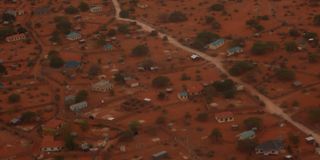Premium
Fresh census ordered in Mandera, Wajir, and Garissa after court quashes 2019 count

An aerial view of structures in a section of Wajir on October 3, 2024.
The High Court has cancelled the 2019 Kenya National Bureau of Statistics (KNBS) census results for Mandera, Wajir and Garissa Counties in the North Eastern region, citing significant irregularities.
Garissa High Court Judge John Onyiego ruled that KNBS failed to uphold fundamental data integrity standards, leading to inaccurate population figures.
“The published results in Volume 1 of the 2019 Kenya Population and Housing Census (KPHC) in respect to the mentioned areas are hereby cancelled,” he stated.

Kenya population census.
The affected sub-counties include Mandera North, Mandera West, Banisa, Lafey, Mandera East, Mandera South, Eldas, Tarbaj, Wajir West, Wajir East, Wajir North, Balambala, Lagdera, Dadaab, and Garissa Township.
The cancellation is a big win for North Eastern leaders, led by then Garissa Senator Yusuf Haji (who died in 2021) and Mandera Governor Ali Roba, who sued KNBS, the National Treasury, Commission on Revenue Allocation, and the Independent Electoral and Boundaries Commission, arguing that the 2019 census results did not reflect actual population figures.
Justice Onyiego ordered a fresh mini-population census in these areas within a year, meaning KNBS must complete the exercise by January 28, 2026.
“That a structural interdict order be and is hereby issued directing the KNBS to conduct a fresh mini-population census in respect to the affected areas within a period of one year from the date of the delivery of this judgment,” the judge said in a judgment dated January 28, 2025.
This means that KNBS has up to January 28, 2026 to repeat the exercise in the affected areas.
Justice Onyiego has further issued orders prohibiting constitutional bodies such as the IEBC, CRA, and the National Treasury from relying on or utilising in any other way Volume 1 of the published disputed 2019 KPHC results in sharing resources or determining boundary delimitation.
“Before a fresh mini-census exercise as directed above is conducted, the CRA, IEBC and the National Treasury shall continue to apply the published census results of 2009 in executing their respective mandates in respect of the affected areas or sub-counties,” said the judge, who noted that the deployment of technology did not in any way jeopardise the outcome of the census.
Justice Onyiego explained that because the results were not verified through scrutiny, the only viable option was to quash them.
He emphasized that the affected communities had a legitimate expectation to have their population properly recorded, as population data directly impacts resource allocation and political representation.
“Population is everything in modern Kenya, where social, economic, and political rights are pegged on numbers,” Justice Onyiego said.
The judge criticized KNBS for failing to disclose that the devices used for data collection were unavailable when scrutiny was ordered.
He questioned inconsistencies in KNBS’s statements regarding the disposal of the devices, which were meant to store census data.
The judge noted that failure to disclose that the devices used in the exercise were not available during the time of scrutiny application was a clear indication that those gadgets were disposed of after the order was issued to defeat the purpose of the scrutiny exercise.
“In further contradicting himself, a KNBS witness, during his cross-examination, stated that they were served with the petition on March 22, 2020. He further stated that by the time they were served, enumeration devices had been reconfigured. This contradicts his testimony that disposal of those devices started June 3, 2020 and concluded on December 21, 2020. Which version does he want us to believe?” the judge asked.
“In any event, those devices had been requested for much earlier before the petitions were filed. Due diligence required that those devices ought to have been preserved. Besides, there was no disposal certificate filed to show how they were disposed, by who, by whom and when. To make a blanket statement indicating the alleged pre-disposal processes does not help,” added the judge.
Senator Haji and Mr Roba had, in their case, claimed that the region’s population had grown steadily since independence until 2009 when disputes arose over alleged data manipulation.
They pointed to drastic population drops between 2009 and 2019 in several sub-counties.
For example, Balambala’s population fell from 94,029 to 32,257 (a drop of 60,772), Lagdera from 92,636 to 50,315 (a drop of 42,321), Lafey from 109,856 to 83,347 (a drop of 26,393), and Tarbaj from 111,846 to 57,232 (a drop of 54,614).
The petitioners argued such drastic declines were implausible, as no significant calamities, wars, or natural disasters had occurred during the period.
“Our population was suppressed for ulterior motives, disenfranchising us in terms of national resource allocation, boundary review, and creation of new constituencies,” they said in court documents.
They further claimed KNBS denied them access to the devices used for enumeration, raising suspicions about data integrity.
They also criticized the rushed release of census results within three months, arguing that KNBS failed to conduct a post-enumeration survey, a standard practice in previous censuses.
The petitioners contended that the 2019 census figures did not align with UN recommendations on census-taking or with past population trends.
Through their law firm Sagana Biriq and Muganda Advocates, they argued that census results for North Eastern counties were “grossly suppressed,” with some areas losing more than 50 per cent of their populations compared to 2009.
They also pointed out that KNBS had denied them access to its servers for scrutiny, reinforcing suspicions of data manipulation.
The CRA acknowledged that from 2013 to 2019, it used 2009 census data to determine revenue sharing.
Similarly, the IEBC admitted that the 2009 figures guided the 2013 boundary review, leading to the creation of new constituencies in the region.
If the disputed 2019 results were applied, some of these constituencies could be abolished.
The 2014–2015 Kenya Demographic and Health Survey indicated that North Eastern counties had the highest fertility rates, were the most polygamous, and had the lowest family planning awareness.
These findings were presented in court to dispute claims of population decline.
KNBS Director-General MacDonald George told the court that a post-census evaluation survey was not conducted due to financial constraints.
Instead, alternative methodologies, approved under UN guidelines, were used.
“During the 2009 census, figures in the North Eastern region were inflated, leading to adjustments through smoothing. The 2019 results were accurate,” he stated, arguing that the decline was due to high out-migration, insecurity, and infant mortality.
KNBS insisted that the timely release of results was due to technological advancements, which enabled faster data transmission.
The agency dismissed the need for a post-enumeration survey, arguing that its alternative methodologies were sufficient.
The dispute centred on what the petitioners called the “actual enumerated population”—figures reportedly gathered unofficially by elders and census officials.
The petitioners argued that KNBS relied on these figures to justify the reduced population data for the affected areas.
With the court now mandating a fresh mini-census, the government has until January 2026 to rectify the figures for the North Eastern region.





